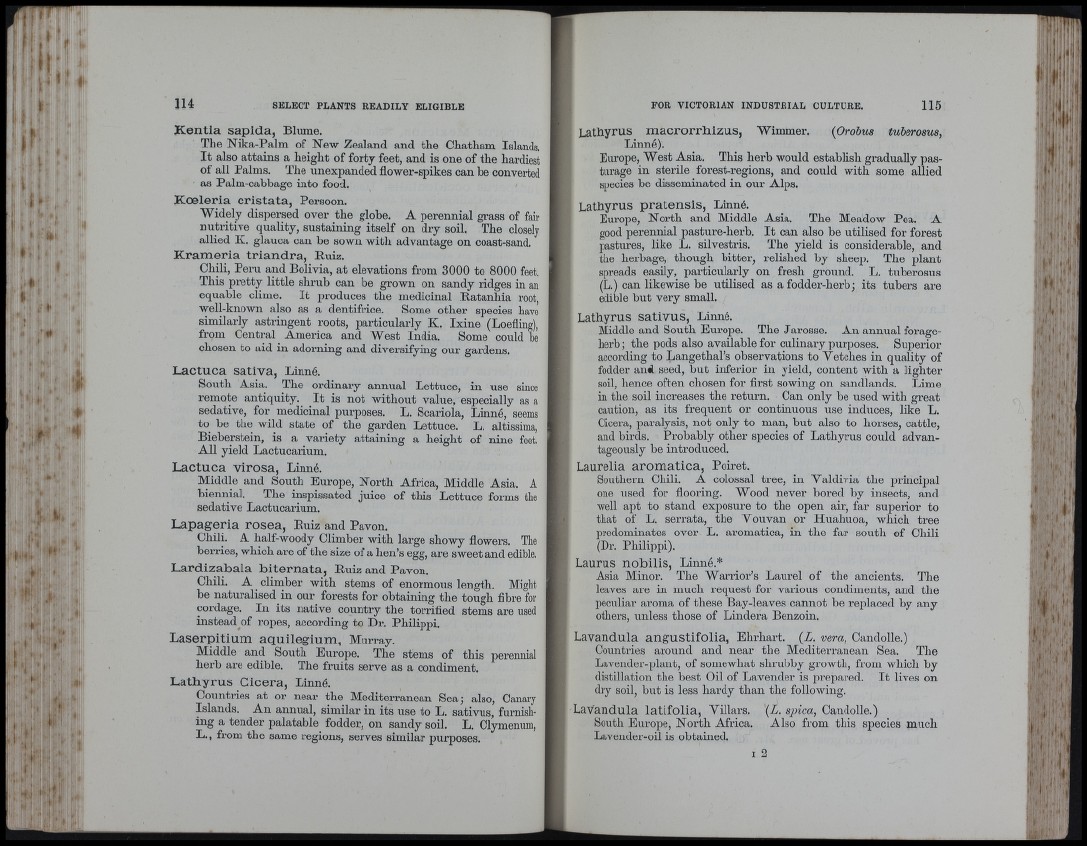
Î '
' i'
' ; ' J
Ï . 4
r i
,1
'i2i,i)■ 11
, I' ■' . ^ Ml*"
:., I»
L.ifi*" fittili:
Kentia sapida, Blume.
The Nika-Palm of New Zealand and the Chatham Islands.
I t also attains a height of forty feet, and is one of the hardiest
of all Palms. The unexpanded flower-spikes can be converted
as Palm-cabbage into food.
Koeleria cristata, Persoon.
Widely dispersed over the globe. A perennial grass of fail-
nutritive quality, sustaining itself on dry soil. The closely
allied K. glauca can be sown with advantage on coast-sand.
Krameria triandra, Buiz.
Chili, Peru and Bolivia, a t elevations from 3000 to 8000 feet,
This pretty little shrub can be grown on sandy ridges in an
equable clime. I t produces the medicinal Batanbia root,
well-known also as a dentifrice. Some other species have
similarly astringent roots, particularly K. Ixine (Loefling),
from Central America and West India. Some could be
chosen to aid in adorning and diversifying our gardens.
Lactuca sativa, Linné.
South Asia. The ordinary annual Lettuce, in use since
remote antiquity. I t is not without value, especially as a
sedative, for medicinal purposes. L. Scariola, Linné, seems
to be the wild state of the garden Lettuce. L. altissima,
Bieberstein, is a variety attaining a height of nine feet.
All yield Lactucarium.
Lactuca virosa, Linné.
Middle and South Europe, North Africa, Middle Asia. A
biennial. The inspissated juice of this Lettuce forms the
sedative Lactucarium.
Lapageria rosea, Buiz and Pavon.
Chili. A half-woody Climber with large showy flowers. The
berries, which are of the size of a hen’s egg, are sweet and edible.
Lardizabala biternata, Buiz and Pavon.
Chili. A clinaber with stems of enormous length. Might
be naturalised in our forests for obtaining the tough fibre for
cordage. In its native country the torrified stems are used
instead of ropes, according to Dr. Philippi,
Laserpitium aquilegium, Murray.
Middle and South Europe. The stems of this perennial
herb are edible. The fruits serve as a condiment.
Lathyrus Cicera, Linné.
Countries at or near the Mediterranean Sea; also, Canary
Islands. An annual, similar in its use to L. sativus, furnishing
a tender palatable fodder, on sandy soil. L. Clymenum,
L., from tbe same regions, serves similar purposes.
Lathyrus macrorrhizus, Wimmer. {Orohus tuberosus,
Linné).
Europe, West Asia. This herb would establish gradually pasturage
in sterile forest-regions, and could with some allied
species be disseminated in our Alps.
Lathyrus pratensis, Linné.
Europe, North and Middle Asia. The Meadow Pea. A
good perennial pasture-herb. I t can also be utilised for forest
pastures, like L. silvestris. The yield is considerable, and
the herbage, though bitter, relished by sheep. The plant
spreads easily, particularly on fresh ground. L. tuberosus
(L.) can likewise be utilised as a fodder-herb; its tubers are
edible but very small.
Lathyrus sativus, Linné.
Middle and South Europe. The Jarosse. An annual forage-
herb; the pods also available for culinary purposes. Superior
according to Langetbal’s observations to Vetches in quality of
fodder and seed, but inferior in yield, content with a lighter
soil, hence often chosen for first sowing on sandlands. Lime
in the soil increases the return. Can only be used with great
caution, as its frequent or continuous use induces, like L.
Cicera, paralysis, not only to man, but also to horses, cattle,
and birds. Probably other species of Lathyrus could advantageously
be introduced.
Laurelia aromatica, Poiret.
Southern Chili. A colossal tree, in Valdivia tbe principal
one used for flooring. Wood never bored by insects, and
well apt to stand exposure to the open air, far superior to
that of L. serrata, the Vouvan or Huahuoa, which tree
predominates over L. aromatica, in the far south of Chili
(Dr. Philippi).
Laurus nobilis, Linné.*
Asia Minor. The Warrior’s Laurel of the ancients. The
leaves are in much request for various condiments, and the
peculiar aroma of these Bay-leaves cannot be rejilaced by any
others, unless those of Lindera Benzoin.
Lavandula angustifolia, Ehrhart. (L. vera, Candolle.)
Countries around and near the Mediterranean Sea. The
Lavender-plant, of somewhat shrubby growth, from wliicli by
distillation the best Oil of Lavender is prepared. I t lives on
dry soil, but is less hardy than the following.
Lavandula latifolia, Villars. {L. spica, Candolle.)
South Europe, North Africa. Also from this species much
Lavender-oil is obtained.
I 2
1
« I
l i t '' ;
F
h';
qU
t l
•i.... 1
■Sî=;
'•ilA
.
1,
I
¿ii-'- f . MM
i j